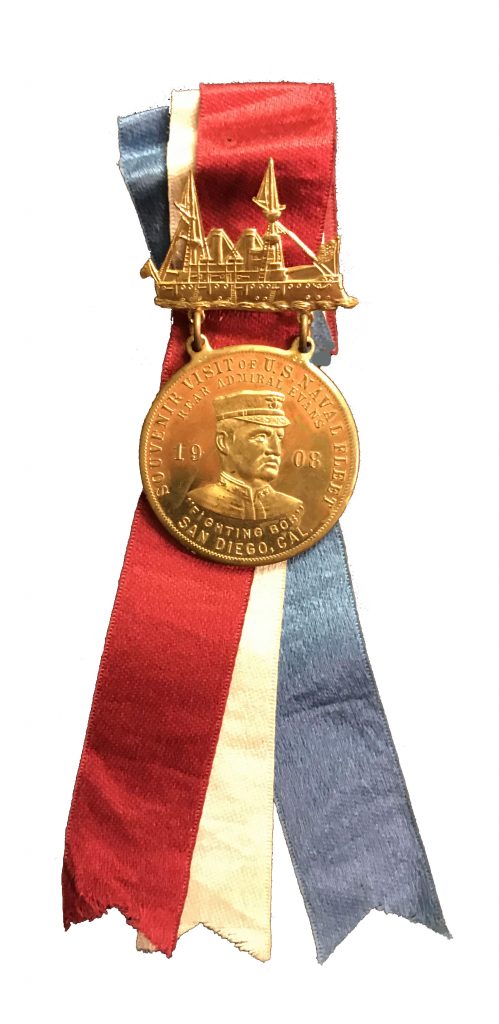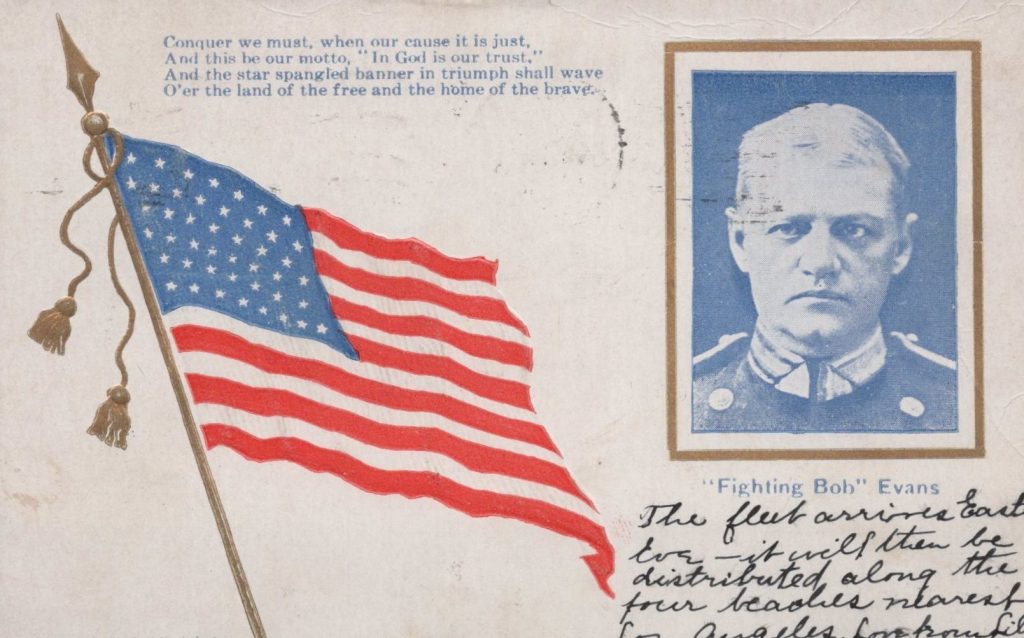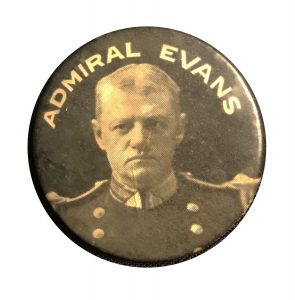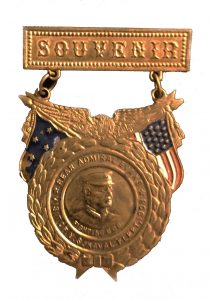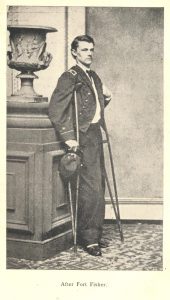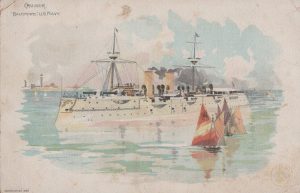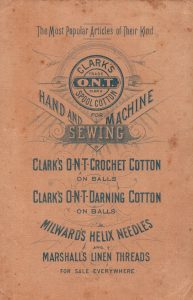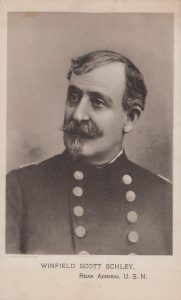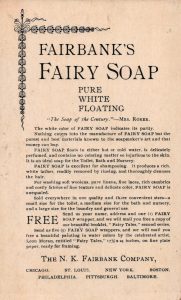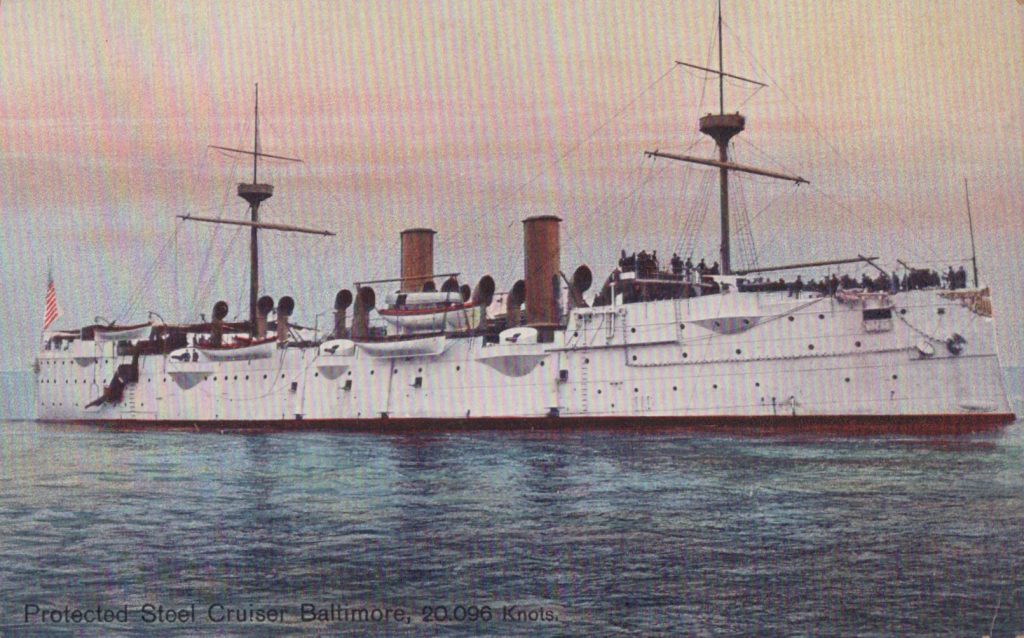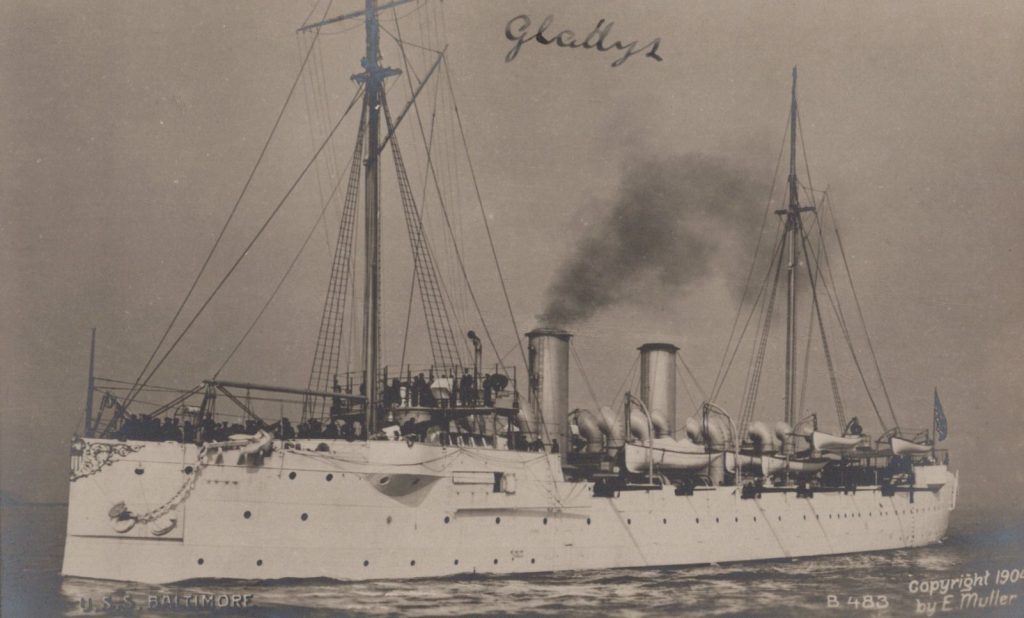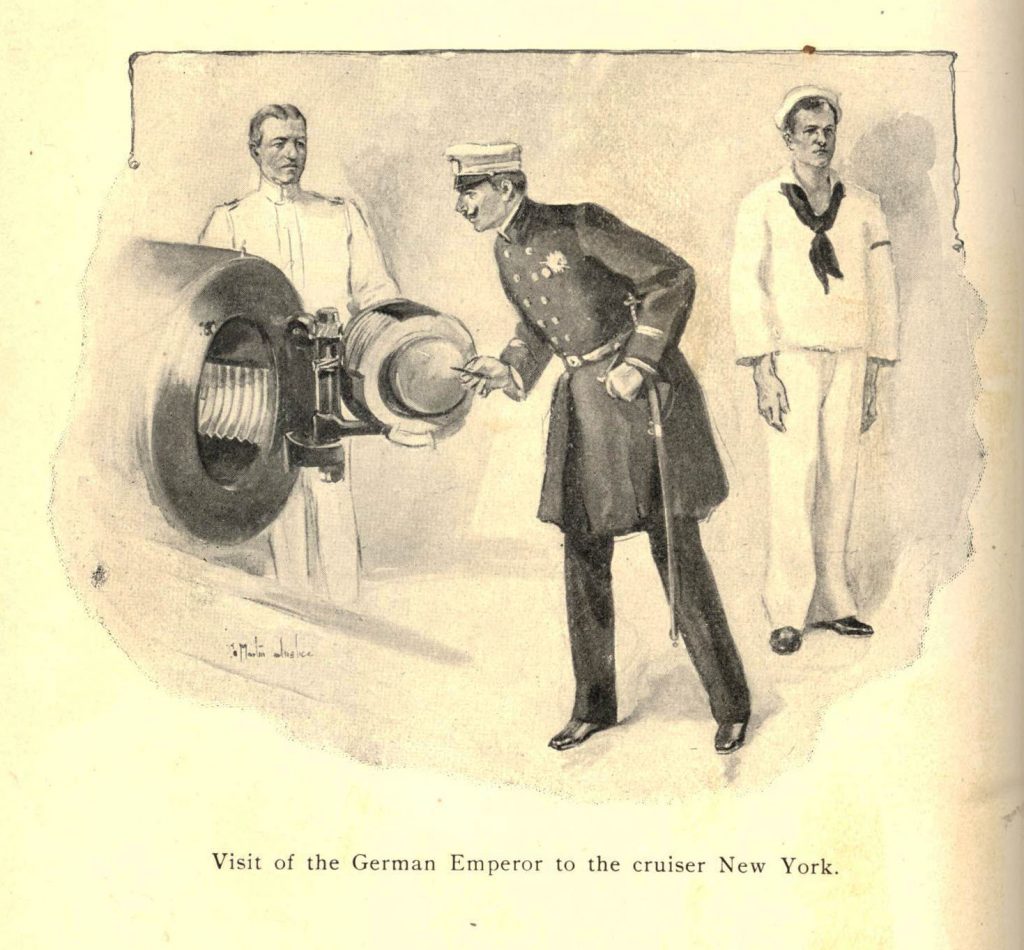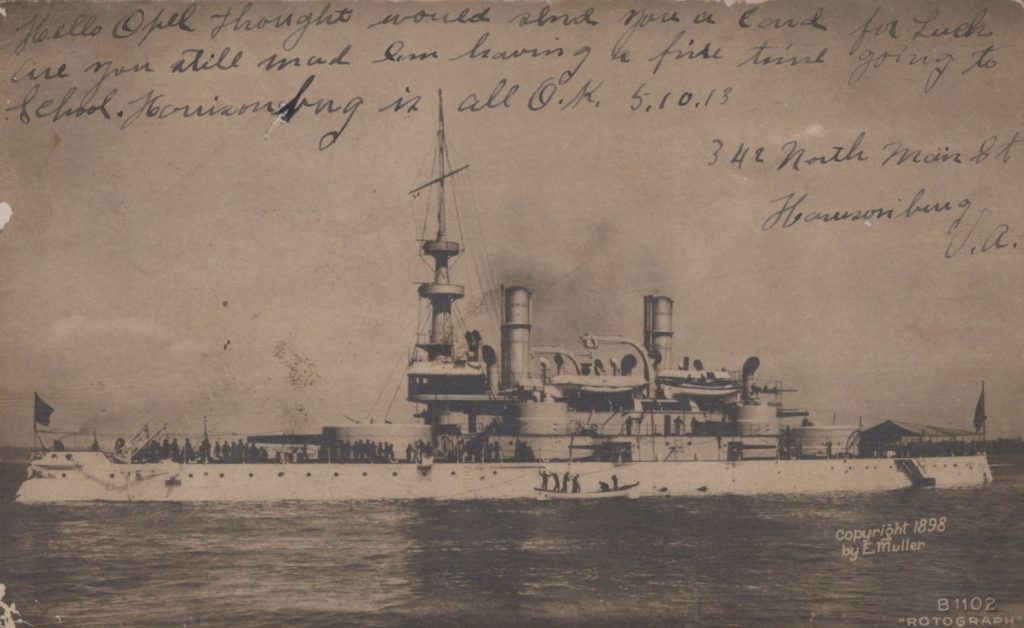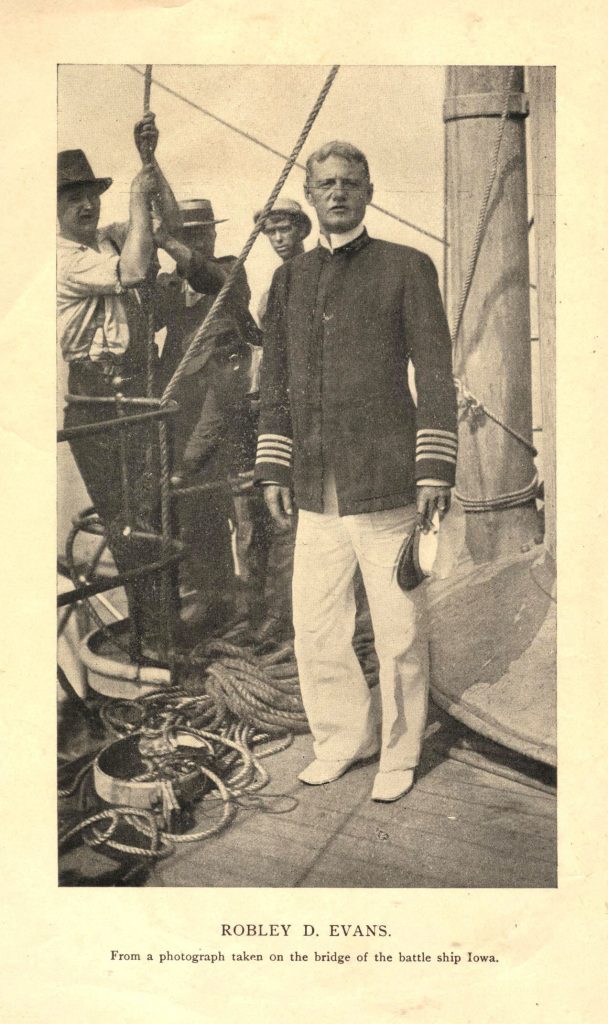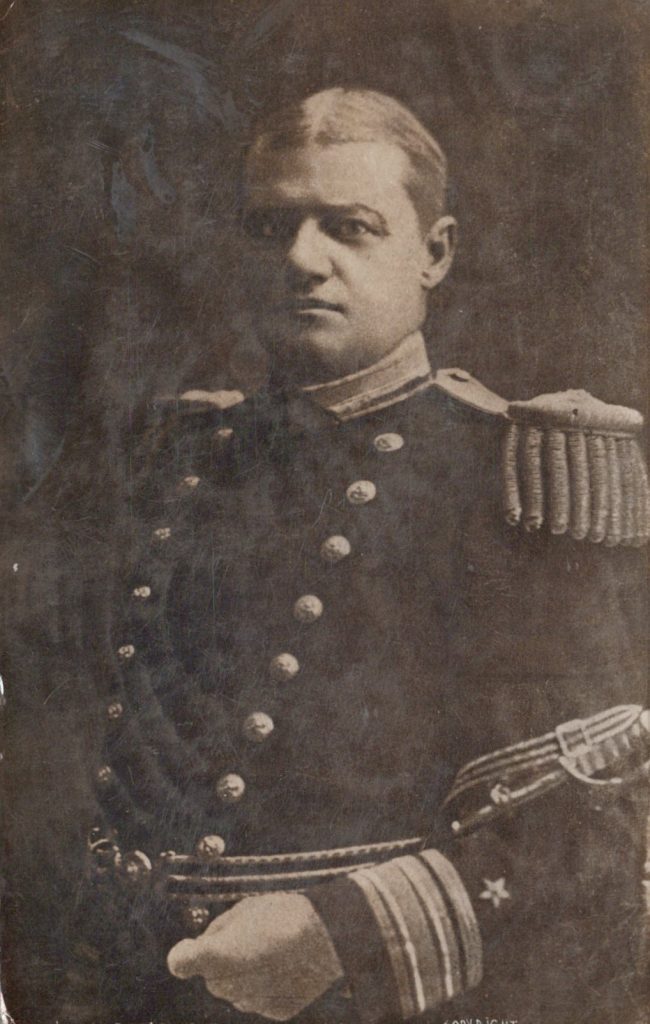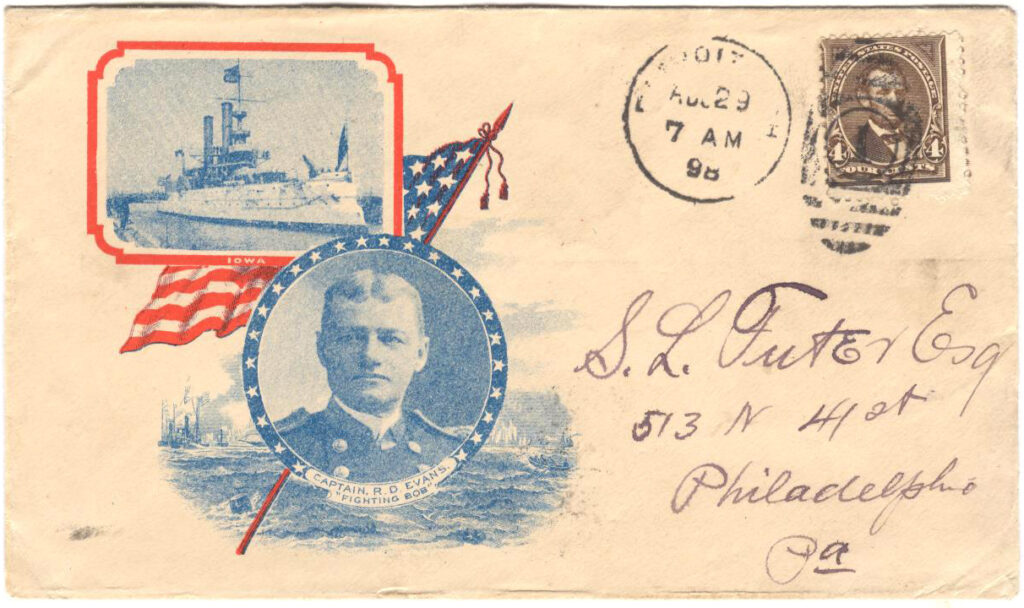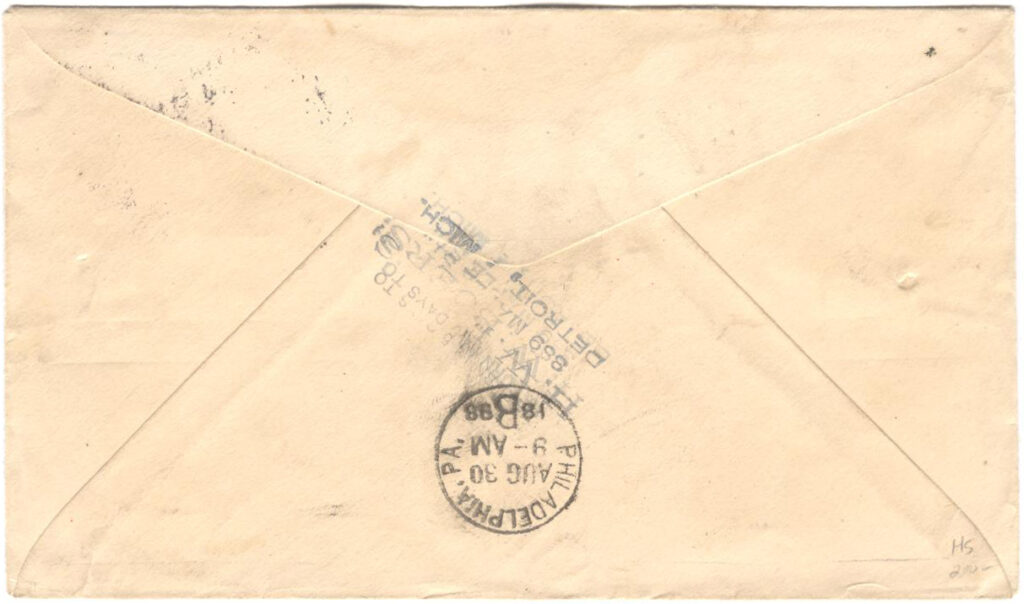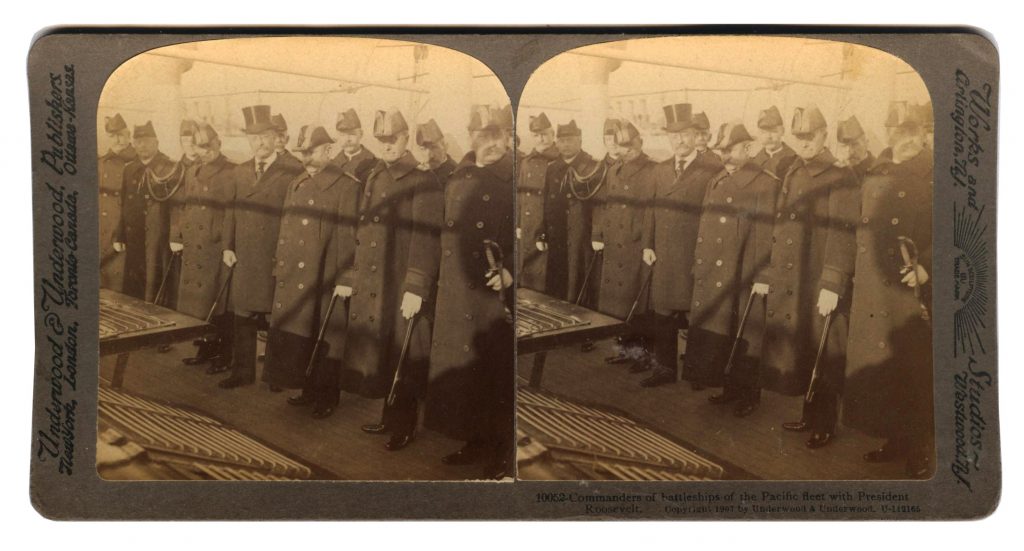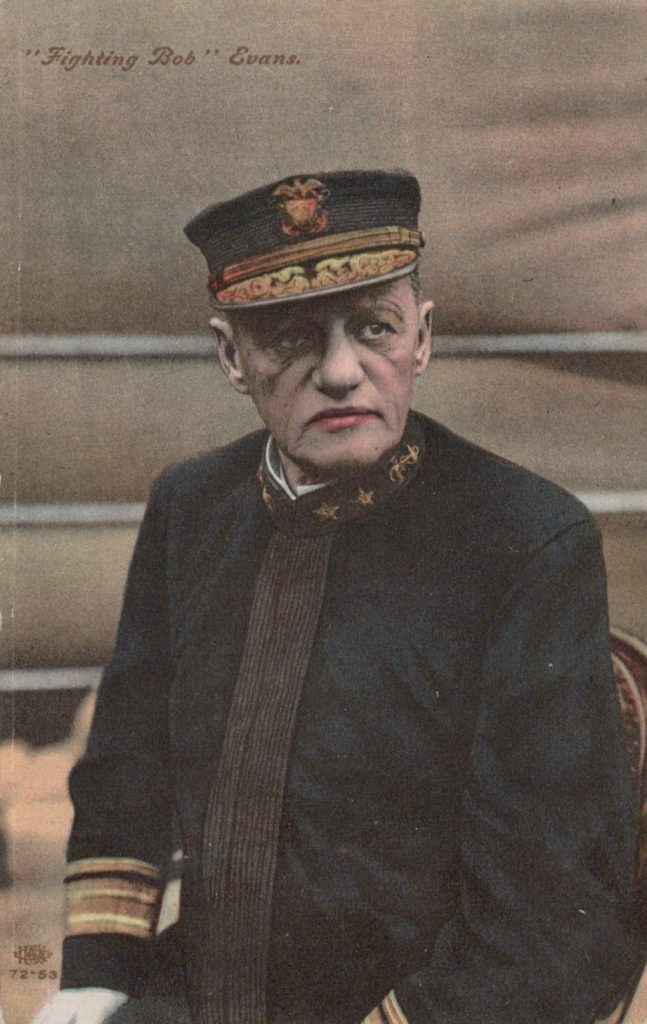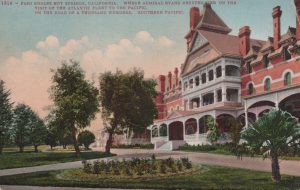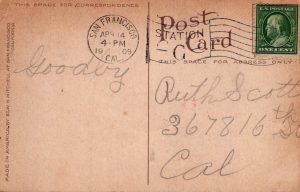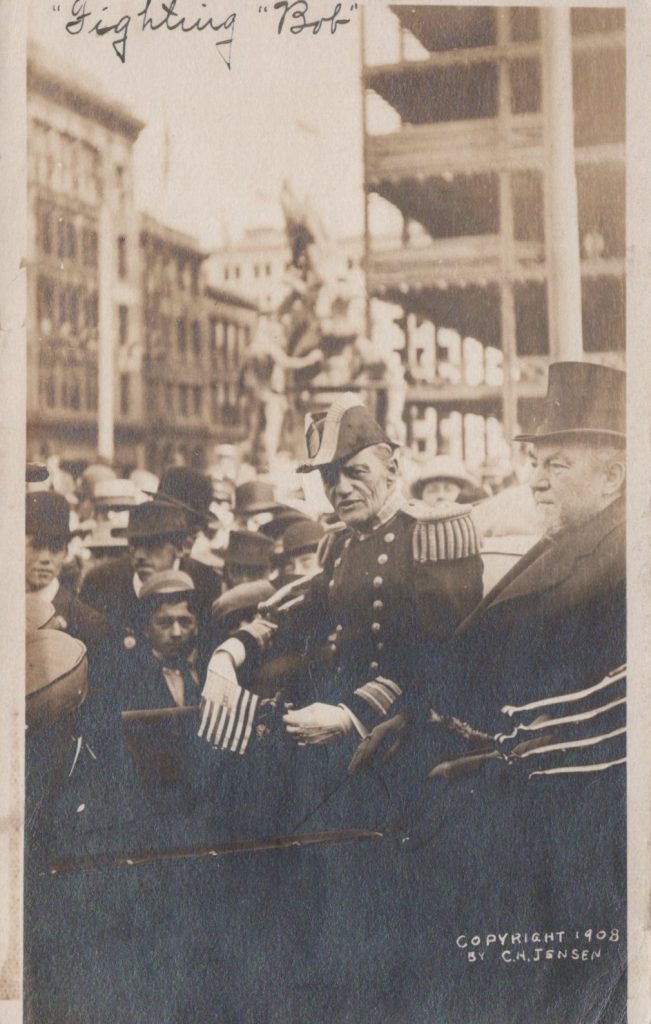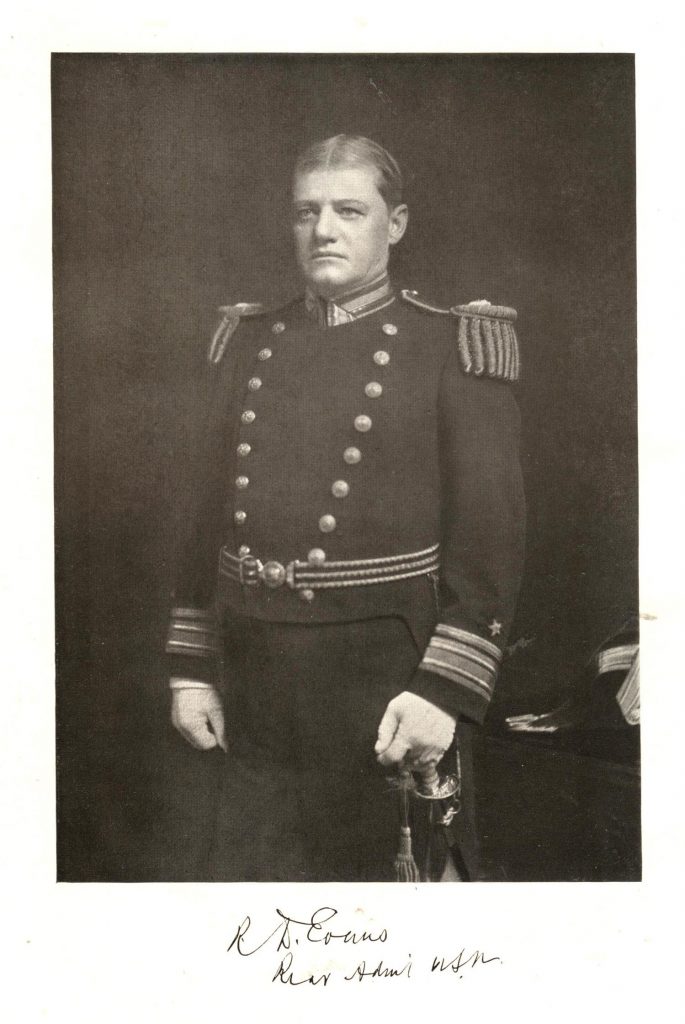Apologies, but no results were found for the requested archive. Perhaps searching will help find a related post.
an american hero
"Fighting Bob" Evans was the embodiment of the American spirit of the time. He was the "John Wayne" of the Navy for his heroic actions as a naval leader. His image was mass produced on everything that was Navy and he was looked up to as an example of the way we wanted to deal with the world, tough, like Teddy Roosevelt.
Born at Floyd Court House, Virginia, (named after the Governor of Virginia), August 18, 1846, his early life was a country life that was in a farming family that held slave. "Life in the mountains of Virginia in my early boyhood days was very different from any I have ever known since. The country was thinly settled, and the people were as rule poor, but what they had they freely shared with their neighbors. Their hospitality was great and sincere. They were honest, hard-working people, who insisted on straight dealing, and they sometimes took the law into their own hands to enforces their ideas." "I remember will what a great joy the harvest season ws to me as a youngster. After following the cradlers, splendid great black fellows, giants in physique, until noon, the cradles were laid aside and the men gathered under the shade trees for their midday meal. Then the man who had led the gang had an extra glass of applejack to encourage him for the afternoon's work, also a few kindly words of encouragement agement from my father, if he happened to be present. That leader seemed to me one of the greatest men in the world!" "My father never sold one of his slaves, yet stories were frequently circulated that he was going to do so, and this led to no end of trouble." After his father's death the slaves working for him were sold with the the property. Robley Evans from "A Sailor's Log." (all quotes and prints shown on this page are from the book "A Sailor's Log" by Robley Evans)
In 1857 he was invited to go live with his uncle in Washington D.C. which he gladly did. "I found this new home a real home, kindness and attention that I could have had from my own parents; they treated me as one of their own children, except that they were never as severe with my small faults as they were with theirs." Robley ended up going to Gonzaga College High School (a Jesuit high school for boys in Washington D.C.), preparatory to Georgetown College where he did not enjoy the formal education and instead watched the sailing ships on the waterfront. His uncle convinced him that if his longing was for the sea, that he could arrange an appointment to the Naval Academy through a friend, Mr. Hooper, the delegate in Congress from the Territory of Utah. In order to get the appointment to Annapolis, he must go to Salt Lake City and live for a year. In 1859 he left Washington by the Baltimore and Ohio Railroad and headed west. Arriving in St. Joseph, Missouri he transferred to a wagon train where he rode a mule on the start of his journey.
Leaving out of Fort Laramie was his first Indian encounter. When a wagon got stuck in the river, hostile Indians set upon his group and stole all of their possessions and burned the wagon. Later after passing through Fort Bridger they were attacked by a hunting party when, during an attack, he was shot through the tendon of his left ankle with an arrow. "My mule had only three arrows in him, but some of the animals resembled the "fretful porcupine," being struck pretty thickly all over."
During his stay in Salt Lake City, Robley felt it his duty to call on Mr. Young (Brigham Young). "I did call, and found the Mormon leader a rugged, hard-looking man, but withal kindly in his manner and good enough to wish me success in the profession I had selected." In 1860 he had secured an appointment to the Naval Academy and returned east to report as an acting midshipman on board the frigate Constitution "Old Ironsides." By 1861, studies were practically suspended in preparations for war with the South. He was initially divided in the war, his family telling him to resign his position and join the fight for the South. His brother enlisted at the age of 14 in the Washington Artillery (Southern forces) where he was twice wounded before returning to the north by the end of the war.
In 1863 he graduated from the Naval Academy and was detailed as a watch officer for the sloop of war Marion and later transferred to the steamer Governor Buckingham as an acting Lieutenant. During the war he was transferred between ships leading to his participation in the attack on Fort Fisher guarding the port of Wilmington, North Carolina. Robley Evans, now and 18-year old Ensign on the Powhatan, led a landing force of sailor to attack the fort. During the bloody attack on the fort Ensign Evans performed heroically to lead the charge and care for his men. They failed to take the fort but had put the Confederate forces on notice that they were a threat to this key position. His wounds from battle were significant. He was brought to the Naval Hospital in Norfolk for treatment. Over-hearing a conversation between surgeons regarding cutting off his legs, Robley informed the doctors that he would rather not live than lose his legs. He was told, "You know, Evans, orders have to be obeyed!" After further discussion on the matter, "Reaching over, I pulled the gun from under my pillow; I told him that there were six loads in it, and that if he or any one else entered my door with anything that looked like a case of instruments I meant to begin shooting, and that he might rest perfectly sure that I would kill six before they cut my legs off." Fighting Bob Evans.
The picture at left is from "A Sailor's Log" by Robley D. Evans
He stayed in the hospital for 5-months, but his wounds healed. When completed he could not bend his right leg and went to Philadelphia to have a doctor look at it and operate. It was a success and the next year he successfully petitioned the Congress to return his commission. For his actions at Fort Fisher he was promoted to Lieutenant. He was assigned to the USS Piscataqua which was at Asiatic station and traveled to China, Japan, and the Philippines. He was impressed with the Japanese culture and the growth of their military. On one occasion he witnessed capital punishment of a man convicted of robbery. It was a quick execution over a pit by a single blow from a long sword. In China, the use of opium interested him, and he tried it! "Before returning to Hong-Kong we desired to smoke opium Chines fashion, that we might know from practical experience what the sensation was like. We borrowed a few Chines experts from the flower boat of a nobleman lying near us, and after due preparation proceeded to smoke. The expert who was giving me his attention prepared a small pill of the opium mixture, and placed it over the pin hole in the pipe, which takes the place of the ordinary bowl. When I had managed to get the large stem of the pipe into my mouth, he applied a red-hot iron to the opium, and the smoking began. I inhaled three whiffs of the smoke, which was all the small pill produced, and then I was very sorry I had done it. All the fine dreams and hallucinations which I had been led to expect and did really expect to experience, were missing, and in their stead I was genuinely seasick-nauseated until I could neither eat, sleep, nor stay awake. The sensation lasted for several days, notwithstanding the large amount of strong tea and coffee I drank, no to mention other liquids. I was quickly and thoroughly cured of my desire to smoke or take opium in any form." (lacking a cabinet card of the Yorktown I offer this beautiful card of her sister Concord)
In 1870 he returned to the States and was assigned to the Washington Navy Yard where he dated and married Charlotte Taylor, a sister of one of his classmates at the Academy. He followed by being transferred to the Naval Academy as an instructor and then sent back to see as navigator of the USS Shenandoah. He patrolled the coast of Spain and returned to the West Indies before being dispatched to the USS Congress as executive officer and promoted to Lieutenant Commander. After a cruise to Africa and the Mediterranean he returned to Philadelphia for the centennial in 1876. He follow on to his first command of the USS Saratoga, a training ship for young sailors transiting the Atlantic 4-times during his tour. In 1880 he was sent back to the Washington Navy Yard and spent the next ten years as an inspector of the Fifth Lighthouse District in Baltimore. A job he did not enjoy doing, but did the job with care and diligence. Things improved in 1891 with his assignment to the USS Yorktown and commanding officer where he was soon dispatched to Chilean waters to support American diplomatic relations resulting from an incident with the USS Baltimore.
On October 16, 1891 a mob attacked a group of sailors on liberty in the Chilean port city of Valparaiso after one of the sailor spit on a picture of Arturo Prat. Tow sailors were killed, eighteen wounded, and 42 arrested. The American government was furious and sent the Yorktown to Valparaiso to join Baltimore while the issue was dealt with diplomatically. Baltimore was commanded by Winfield Scott Schley, later a hero of the Spanish American War for his actions in Santiago de Cuba, who was not liked by the local government in Valparaiso. After arriving on station Evans made his rounds to all of the local government officials and the representatives of other nations. Two weeks later the Baltimore departed and Evans was left to manage the situation while the two governments talked. The Chilean government tried his patience at every turn. At one point they sent torpedo boats directly at the Yorktown while at anchor in the harbor. Evans responded that the ship was property of the United States Government and that even a scratch was put on the paint he would respond by sinking the offending torpedo boat. While returning from shore one day a mob started throwing stones at his boat. He informed the Chilean government that his crew on official business ashore would be armed and would shoot anyone who insulted or tried to cause harm to them. He earned the respect of the Chilean government and stayed in the harbor for almost 2-months until reparations where agreed upon.
USS Baltimore (C-3) was built by plans purchased from Armstrong, a British manufacturer, at Cramp & Sons in Philadelphia and commissioned in January 1890. She was of the same design as the Charleston but improved with more guns, thicker armor, and better machinery. She had a very long history of service from before the Spanish-American War through WWI being altered in 1914 to a mine laying ship that planted over 1,000 mines during WWI to support the protection of shipping during the war. She served as a receiving ship at Pearl Harbor and was present during the Japanese attack on December 7, 1941 and was towed to sea and scuttled the next year. In 2017 the Hawaii Undersea Research Laboratory found the wreck off the coast of Oahu and has surveyed the remains.
He was next tasked with enforcing the new sealing laws that applied to the waters around Alaska. Taking the Yorktown north in the harsh region of Alaskan waters was a challenge. Yorktown left from Port Townsend, Washington after serving notice to 110 sealing vessels not to enter the Bering Sea to hunt the seals. "My men suffered from exposure and the lack of fresh provisions, but we were always able to give them all the fresh fish they wanted. We had only to stop the engines and get the lines overboard, and in a few hours catch three or four hundred pounds of beautiful codfish. Sometimes I gave them salmon, but I soon found that they could not eat this many day in succession - it was too rich." His efforts that season led to the capture of the British steamer Coquitlan with over 30 thousand skins in her cargo and was taken prize to Sitka and bonded for six-hundred thousand dollars to the United States Treasury.
For this and his actions in Chile he was promoted to Captain upon return to the United States and given command of the new battle cruiser New York. It was the largest naval vessel of her time.
At right an early postcard of the USS New York, undivided back, Souvenir Card by J. S. Johnson, N.Y.
His first adventure as Captain of the New York was to take his ship on a North Atlantic cruise to end up in Kiel, Germany. New York was to meet up with ships from other nations to celebrate the opening of the Kiel Canal on June 25, 1895 by Kaiser Wilhelm II. A short movie clip of this event was actually filmed in 1895 and can be seen at this link. click here.
On the evening of June 26th, the Emperor and Prince Henry and ten admirals came aboard the New York to dine. The evening was kicked-off by re-naming the twelve-oared cutter that had won the rowing competition between ships after Admiral Kirkland's daughter, Victoria Louisa, and three cheers and a tiger for the emperor. "At 1 am the emperor expressed a desire to inspect the engine room. And so we did. He looked into every hole and corner, and even had us disconnect one of the engines, marking time on us himself. Then we went through the gun deck and out on to the forecastle, where he asked how long it would take to close all watertight doors. I replied that in the daytime we could do it in thirty seconds, but at night it required about two minutes. Much to my surprise, he asked if I would mind doing it for him. Of course I had to say yes, but when I tried to blow the siren, there was not steam enough, and the blessed thing would not blow. The emperor thought he had me, and said "Now you see captain, you can't close your bulkheads." But he did not know everything. I said "You will see in a moment, sir, " and I touched one of the general alarm buttons, which calls all hands to quarters, and in a few seconds the men were swarming up like rats. The emperor took the time himself, and in one minute and a half the entire ship was ready for action with all water-tight doors closed."
In October 1895 Evans was ordered to Philadelphia to fit out and command the first battleship Indiana being built at Cramp's shipyard. At the time it was the heaviest armed and armored ship in the world with four thirteen-inch breech-loading cannon in turrets mounted forward and aft. While steaming off the Virginia/North Carolina coast the ship and crew were tested in heavy weather. "At midnight the gale was very bad and the sea coming on board in every direction. The night was as black as a pocket and the rest of the squadron out of sight ahead. I had been forced to slow down to protect the men and officers who were working on the forcastle in a desperate effort to secure the forward thirteen-inch turret, which was thrashing from side to side as the ship rolled and pitched. I stood by the wheel on the upper bridge, and frequently the whole forward end of her would go under water, men and all, and the sea would come up until I could easily have put my foot into it. At such times I held by breath as the water rolled off and the black heads of the offers and men, one after another, came in sight; I fully expected to see them swept overboard by the dozen. She was rolling forty degrees, and nothing I could do seemed to ease her. The sea was so irregular that I could not keep her bows on to it, and the night so pitch dark that I could not see where the heavy seas were coming from. The carpenter, who was in a great funk, came to me on the bridge, white in the face, and reported in a trembling voice, "Sir, the gun deck is full of water, and I can't see how we are ever going to get it out!" I replied, "Go down and drink some of it out, sir, and don't bother me again with your whining!"
""By the almost super-human efforts of the executive officer and the officer of the forward turret, assisted by one hundred or more men, the thirteen-inch guns were finally lashed securely to the eight-inch turret on the upper deck, and the forward turret thus secured. The work required 4-hours, most of the time all hands engaged in it were under water. In the meantime the lifeboats, which were hoisted on the upper deck of all, were smashed by the sea, which came up under them and stove them against the davit heads. By four o'clock in the morning we had everything well secured and the water all cleared out, so that I felt no apprehension for the safety of the ship. Between midnight and four in the morning one of the young officers lost his leg by having it caught by an armored door weighting two tons, which, unfortunately, carried away its fastenings at the wrong moment and close just when the young man was thrown out of his bunk across the door-sill. This was the only serious accident we had, through many of the men were somewhat bruised.
In 1897 war with Spain was approaching, Captain Sampson, now in charge of the Atlantic Fleet, order Evans to take command of the USS Iowa, the finest battleship in the navy. Upon assuming command he prepared the ship for war with drills daily and gunnery practice a priority. The news of the sinking of the Maine brought things to a head. War was declared and McKinley ordered the blockade the coast of Cuba. On April 22 his ship in company with the squadron were standing off Havana to enforce the blockade.
When news came that the Spanish fleet had been sent, the fleet got underway to meet them at San Juan, Puerto Rico. The fleet was not there and Sampson decided to engage the fort and the City with shelling. The fort returned fire during these engagements hitting the Iowa once.
His next engagement was at Santiago where they bottled up Cervera's fleet in the harbor. The American squadron sited the cruiser Cristobal Colon in the harbor and set up a blockade. In addition, the American army was closing in on the city with 16,000 men and 3,00 rebel insurgents. The squadron in the harbor included Almirante Oquendo, Vizcaya, Infanta Maria Tersa, and the Cristobal Colon. The top military commander for Spain in Cuba ordered Cervera to sortie from the harbor. The American navy had two squadrons, one under Admiral Sampson, the other under Admiral Schley, well armed and waiting outside the harbor at 6 miles. After a month long stand-off on Sunday, July 3rd, the Spanish navy decided, "It is better for the honor of our arms that the squadron perish in battle ..."
The American blockade formation that morning consisted of Schley's Brooklyn, battleships Texas, Oregon, Iowa and Indiana and the armed yachts USS Vixen and Gloucester. As the left the mouth of the harbor the battle commenced almost immediately with Texas, Iowa, Oregon, and Indiana opening fire. Iowa was hit by two shots from the Colon, one near the waterline. It was an intense naval battle that finished with the American fleet victorious. Iowa and Gloucester sank the destroyer Pluton and damaged the Furor until she ran herself aground. The Colon was beached. Iowa pursued the flagship Vizcaya and with intense fire ran her aground. When Vizcaya exploded, Evans sent his crew to rescue the Spanish sailor, including the captain of the ship. The captured captain tried to offer his sword in surrender, but the sword was not accepted and Evans allowed the captain to share his quarters while recovering from his wounds.
The solemn moment has arrived to fight. This is what the sacred name of Spain and the honor of its glorious flag demands of us. I wanted you to attend this appointment with the enemy with me, wearing the dress uniform. I know that this order is strange, because it is improper in combat, but these are the clothes that the sailors of Spain dressed in great solemnities, and I do not believe that there is more time in the life of a soldier than that in which he dies for the Homeland. The enemy codes our old and glorious hulks. For this he has sent against us all the might of his young squadron. But only the splinters of our ships will be able to take, and only snatch our weapons when, corpses, we float on these waters, which have been and are from Spain.
My sons! The enemy surpasses us in the forces, but it does not equal us in value.
Nail the flags and not a single prisoner!
Endowment of my squad: Long live Spain!
Battle stations, and may the Lord welcome our souls!
- Pascual Cervera y Topete's speech before the Battle
It was a great victory for the U.S. Navy. Reports of the battle indicate that Iowa and Brooklyn inflicted 70% of the damages to the opposing fleet. These were the closest two ships to the battle. Iowa expending 1,473 rounds of ammunition (bill shells plus smaller rounds) and Brooklyn expending 1,973 rounds. The American ships were faster. Admiral Sampson's assessment of the shore batteries being ineffective was accurate and they played no role in the battle. The training of the gunnery crews for the Spanish fleet was poor and the ammunition had weak charges. Their lack of high quality coal for their boilers reduced their speed and hampered the ability to maneuver or escape.
"USS Iowa, First Rate, San Francisco, February 14, 1899 - Captain robley d. evans, usn
From "A Sailor's Log" - "Some time after I left the Iowa I received a beautiful sword, which I value above all my earthly possessions, and the following letter: "Sir: The members of this ship's company, who had the high honor of serving you from San Juan to Santiago, beg leave to present this sword as a token of our affection and reverence. It has been our intention to make this presentation when you relinquished command, but owing to the disintegration of the crew following our arrival at New York in August last, and our hurried departure, it was not done. Coming at this late day, it will show you sir, that this action is not from momentary impulse, but that the affection and respect of this crew for you is deep-rooted and lasting, and that the men of the battle ship Iowa will ever cherish the memory of their beloved commander. And with this sword we send our wishes for your health and happiness always. It is an assurance from us that you are more than a hero to a nation - you are a hero to your men. Very respectfully, F. Zulch, A. E. Moore, J. Collins, Chief MAA, E. McCormack, H. Enels, Holt, Committee."
The article at left from the New York Times further describes the inscription: "To our hero - Too just to take a fallen foe's - We give this sword instead." This referred to Captain Evans' refusal to accept Captain Don Antonio Eulate's sword after the Battle of Santiago. (postcard at right postmarked Seattle, May 1908)
Below is a cache cover dated August 29th, 1898 showing Captain R. D. Evans, "Fighting Bob" with the Battleship Iowa and the American flag in the background.
Over the next few years Evans grew in rank and position within the navy to Rear Admiral and Commander-in-Chief of the Atlantic Fleet. He continually advised the Theodore Roosevelt on naval matters and was instrumental in the decisions that sent the battleship fleet around the world. From his experience at war, his talent at diplomacy, and respect of a nation, it is clear why he was selected, despite is health issues, to command the fleet on this journey. The Underwood & Underwood stereoview card below shows President Roosevelt on the Mayflower for the departure of the fleet at Hampton Roads. To his right is Rear Admiral Evans, to his left is Read Admiral Thompson and Sperry.
Unfortunately, early in the cruise on the first leg around South American his health failed him. His injuries from the Civil War caused him great pain and he spent much of his time in his quarters suffering.
Admiral Thompson assumed much of the responsibilities during this portion of the cruise and received communications from Evans regarding his concerns.
Upon arrival at Magdelina Bay, Evans departed in the Connecticut and went north to seek medical treatment at a Hot Springs in Paso Robles. This was a common treatment for chronic pain.
The fleet parade in San Francisco was a send-off to an American hero. Admiral Evans rode in the parade with the Mayor of San Francisco as his final farewell to the Nation.
in honor of admiral evans
On August 18, 1908, while the fleet was still on the world cruise, Robley Evans retired from the navy on his 62nd birthday. The occasion was held at the Lake Mohonk Mountain House in New York. "Fighting Bob" had completed 48 years of active service in the United States Navy and was transferred to the retired list.
The event at the Mononk was attended by over 600 guests with decorations including the flags that flew from the Iowa and Connecticut. In his parting address: "That I have suffered severely under that flag must be evident to anyone who sees me, but I would live my life over again just as I have lived it if I knew the suffering was to be a thousand times as great."
Robley Evans died January 3, 1912 in Washington D.C. and was buried in Section 1 of Arlington National Cemetery with his wife Charlotte Taylor Evans.
(Event booklet with inside cover photograph)

